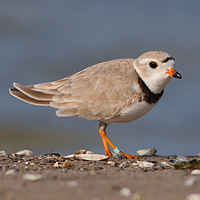Piping plover
Scientific name: Charadrius melodus

Cover photo credit: Brendan Toews
Status
Endangered
“Endangered” means the species lives in the wild in Ontario but is facing imminent extinction or extirpation.
Date added to the Species at Risk in Ontario List
The Piping Plover was already assessed as endangered when the Endangered Species Act took effect in 2008.
What it looks like
The Piping Plover is a small shorebird that is well-camouflaged on the pale sand beaches it favours.
Its stubby bill is orange with a black tip and its legs are bright orange. Its belly is white but the back, wings and most of the tail are the colour of dry sand.
Adults have a bold black breast band and a smaller black band above their white forehead.
Where it lives
Piping Plovers nest exclusively on dry sandy or gravelly beaches just above the reach of high water and waves.
When not migrating, this bird spends virtually all of its time between the water’s edge and the back of the beach.
It pecks the sand and searches small pools of water for food - mostly insects and small crustaceans.
Where it’s been found in Ontario
In North America, the Piping Plover primarily breeds along the Atlantic coast, the western Great Lakes and along wetlands, rivers and lakes in the northern Great Plains.
In Ontario, although never common, they breed along the shores of the Great Lakes, and at Lake of the Woods in northwestern Ontario.
View a Larger version of this map (PDF)
What threatens it
The main threat to the Piping Plover is human disturbance, since the sandy beaches where plovers live are also popular for human recreation which can destroy nests.
Groomed beaches lack natural hiding places, making eggs and chicks vulnerable to predators such as foxes, cats, raccoons and gulls.
Storm surges and severe weather can also destroy nests and harm chicks.
Action we are taking
Endangered Species and their general habitat are automatically protected
Recovery strategy
A recovery strategy advises the ministry on ways to ensure healthy numbers of the species return to Ontario.
Read the executive summary (May 31, 2013)
Read the recovery strategy (May 31, 2013)
Government response statement
A government response statement outlines the actions the government intends to take or support to help recover the species.
Read the government response statement (March 14, 2014)
Review of progress
A review of progress made toward protecting and recovering a species is required no later than the time specified in the species’ government response statement, or not later than five years after the government response statement is published if no time is specified.
Read the report on progress towards the protection and recovery of 16 species at risk, including Piping Plover (Charadrius melodus) (2019).
Habitat protection
General habitat descriptions are technical, science-based documents that provide greater clarity on the area of habitat protected for a species.
Read the general habitat description (July 2, 2013)
What you can do
Report a sighting
- Report a sighting of an endangered animal or plant to the Natural Heritage Information Centre. Photographs with specific locations or mapping coordinates are always helpful.
- Bird Studies Canada is working to advance the understanding, appreciation and conservation of wild birds and their habitat in Ontario and elsewhere.
Volunteer
- Volunteer with your local nature club or provincial park to participate in surveys or stewardship work focused on species at risk.
Be a good steward
- Private land owners have a very important role to play in species recovery. If you find a nesting on your land, you may be eligible for stewardship programs that support the protection and recovery of species at risk and their habitats.
- If you’re visiting a beach where Piping Plovers are known to nest, obey all protective measures and signs. Walk near the shoreline rather than the dry sand near the back of the beach (where the birds like to nest), keep pets away, and do not drive off-road vehicles on beaches or dunes. Make sure to clean up after your visit, as leaving garbage or food on the beach can attract predators that may eat eggs and chicks.
- As with all wildlife, don’t disturb nests, young or adults. Be respectful and observe from a distance.
Report illegal activity
- Report any illegal activity related to plants and wildlife to
1-877-TIP-SMNR (847-7667)
Quick facts
- Over the past 50 years, Piping Plovers vanished from almost all known nest sites on the Great Lakes, and were reduced to just a handful of pairs in northern Michigan. However, intensive management and protection in Michigan is succeeding and the young from this location are now helping to repopulate former breeding sites along Ontario’s Great Lakes shorelines.
- Within an hour of hatching and drying off, Piping Plover chicks, like other shorebirds, are able to find their own food.
- In the spring, a male Piping Plover establishes a territory and attracts a female mate by performing dramatic displays in the air and on the ground. He then scrapes out a shallow nest in the sand and presents it to the female for inspection.
- Piping Plover parents share the duty of incubating eggs and caring for their newly hatched nestlings.
